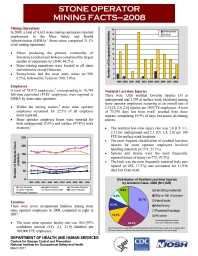Mining Publication: Stone Operator Mining Facts - 2008
Original creation date: March 2011
Mining Operations: In 2008, a total of 4,633 stone mining operations reported employment to the Mine Safety and Health Administration (MSHA). Stone mines comprised 31.1 % of all mining operations. 1. Mines producing the primary commodity of limestone (crushed and broken) comprised the largest number of operations (n=2,046; 44.2%). Stone mining operations were located in all states and territories except Delaware. Pennsylvania had the most stone mines (n=394; 8.5%), followed by Texas (n=360; 7.8%). Employees: A total of 78,975 employees, corresponding to 76,749 full-time equivalent (FTE) employees, were reported to MSHA by stone mine operators. 1. Within the mining sectors, stone mine operator employees accounted for 22.5% of all employee hours reported. 2. Stone operator employee hours were reported for both underground (2 .6%) and surface (97.4%) work locations. Fatalities: There were seven occupational fatalities among stone mine operator employees in 2008, compared to eight in 2007. 1. The stone mine operator fatality rate was 10.6 [95% confidence interval (CI): 4.3, 21.9] fatalities per 100,000 FTE employees. Nonfatal Lost-time Injuries: There were 1,626 nonfatal lost-time injuries (33 at underground and 1,593 at surface work locations) among stone operator employees occurring at an overall rate of 2.5 [CI: 2.4, 2.6] injuries per 100 FTE employees. A total of 75,970 days lost from work resulted from these injuries, comprising 19.9% of days lost across all mining sectors. 1. The nonfatal lost-time injury rate was 1.6 [CI: 1.1, 2.3] for underground and 2.5 [CI: 2.4, 2.6] per 100 FTE for surface work locations. 2. The most frequent classification of nonfatal lost-time injuries for stone operator employees involved handling materials (n=571; 35.1 %). 3. Sprains and strains were the most frequently reported nature of injury (n=772; 47.5%). 4. The back was the most frequently reported body part injured (n=282, 17.3%) and accounted for 11,936 days lost from work.
Authors: NIOSH
Brochure/flyer - March 2011
NIOSHTIC2 Number: 20039162
Pittsburgh, PA: U. S. Department of Health and Human Services, Public Health Service, Centers for Disease Control and Prevention, National Institute for Occupational Safety and Health, DHHS (NIOSH) Publication No. 2011-166, 2011 Mar; :1-2
See Also
- Coal Operator Mining Facts - 2005
- Metal Operator Mining Facts - 2002
- Metal Operator Mining Facts - 2004
- Metal Operator Mining Facts - 2005
- Noncoal Contractor Mining Facts - 2003
- Nonmetal Operator Mining Facts - 2002
- Nonmetal Operator Mining Facts - 2008
- Sand and Gravel Operator Mining Facts - 2006
- Stone Operator Mining Facts - 2003
- Stone Operator Mining Facts - 2005
- Page last reviewed: 10/5/2012
- Page last updated: 10/5/2012
- Content source: National Institute for Occupational Safety and Health, Mining Program


 ShareCompartir
ShareCompartir
